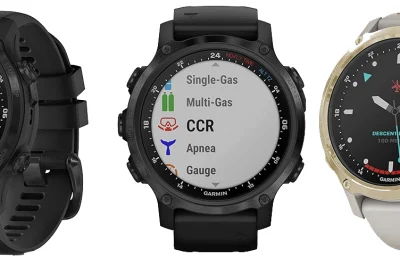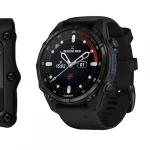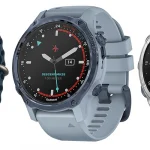Unveiling Critical Data Metrics for Optimal Recovery

Table of Contents
- Unveiling Critical Data Metrics for Optimal Recovery
- Debunking Common Myths About Dive Fatigue
- Avoiding the Most Common Recovery Mistakes
- Forecasting the Future of Dive Recovery Technology
- Choosing the Right Diving Computer for Seamless Recovery
- The Impact of Data-Driven Decisions on Dive Endurance
- Top Recovery Features to Look For in a Diving Computer
- Evaluating Recovery Metrics: The Florida Instructor’s Approach
Introduction
In the world of scuba diving, post-dive recovery is as critical as the dive itself, helping enthusiasts achieve optimal performance and mitigate fatigue. This article delves into the key data points that diving instructors in Florida rely on to enhance post-dive recovery using modern diving computers, offering a clear path for divers looking to make an informed purchase.
Unveiling Critical Data Metrics for Optimal Recovery
Debunking Common Myths About Dive Fatigue
Fatigue in scuba diving is often misunderstood, with several persistent myths that can mislead divers about its causes and prevention. Addressing these misconceptions is crucial for divers aiming to optimize their post-dive recovery and select the right diving computer to aid them.
- Myth 1: Nitrox Reduces Fatigue
Many divers believe breathing Nitrox significantly cuts down on post-dive tiredness because it reduces nitrogen absorption. While Nitrox does extend bottom times and lowers nitrogen levels during a dive, scientific evidence does not conclusively prove it prevents fatigue. In fact, the higher oxygen concentration in Nitrox can lead to oxidative stress, which might contribute to fatigue symptoms rather than alleviate them. Personal experiences vary, but relying solely on Nitrox to reduce fatigue is an oversimplification. - Myth 2: Diving Isn’t Physically Demanding
A common misconception is that diving is mostly passive and doesn’t cause substantial exertion. In reality, an hour-long dive can expend energy comparable to playing tennis for an hour due to water resistance, buoyancy control, and carrying equipment. Underestimating this physical demand can lead divers to neglect proper conditioning and recovery strategies, inadvertently increasing fatigue risks. - Myth 3: Alcohol, Especially Beer, Eases Decompression
Some divers hold the dangerous belief that consuming beer or light alcohol post-dive helps with decompression or fatigue recovery. This is false and harmful since alcohol dehydrates the body and impairs cognitive and motor functions. Proper hydration with water is vital for efficient nitrogen elimination and reducing fatigue.
Modern technology plays a key role in dispelling these myths by providing data-driven guidance that supports better dive management and recovery:
- Nitrox-Compatible Dive Computers: These devices accurately monitor oxygen and nitrogen exposure, ensuring divers stay within safe limits during their underwater time. While they don’t guarantee less fatigue, they optimize decompression algorithms to reduce unnecessary exertion during safety stops and ascents.
- Advanced Dive Planning Software: By designing dive profiles that minimize rapid ascents and excessive depths, these tools reduce physical strain and nitrogen loading, an indirect but effective approach to managing fatigue.
- Hydration Tracking Apps and Reminders: Some divers use apps or wearables to prompt hydration before and after dives, helping avoid the dehydration that contributes to tiredness and delayed recovery.
- Emerging Technologies: Although not yet widespread, future innovations may include physiological sensors integrated into dive computers or wearables that monitor exertion levels, heart rate, or other biometrics underwater to provide personalized feedback and prevent overexertion.
Understanding these myths and leveraging technology correctly empowers scuba divers, particularly in dynamic environments like Florida where dive conditions vary, to mitigate fatigue effectively and make informed decisions when selecting a dive computer.
Debunking Common Myths About Dive Fatigue
Common Post-Dive Recovery Mistakes and How Diving Computers Help Avoid Them
Even the most experienced divers can fall into common post-dive recovery errors that increase the risk of decompression sickness (DCS) and fatigue. Understanding these pitfalls—and leveraging the data and features that modern diving computers provide—can make all the difference in safely optimizing recovery.
1. Skipping or Shortening Surface Intervals
A critical error is not respecting adequate surface intervals between dives, which prevents sufficient off-gassing of nitrogen absorbed during the dive. Cutting these rest times short elevates the risk of micro-bubble formation, leading to DCS.
Diving computer solution: Advanced dive computers monitor your entire dive profile—depth, time, and previous dives—to calculate mandatory surface intervals accurately. By displaying required rest periods before another dive or flying, they ensure you don’t deviate from safe off-gassing windows.
2. Flying or Traveling to High Altitudes Too Soon After Diving
Ascending to high altitude too quickly after diving causes rapid pressure changes that can exacerbate residual nitrogen bubble formation, increasing decompression sickness risk.
Diving computer solution: Many dive computers include pre-flight surface interval recommendations, typically advising 12 to 24 hours based on your dive history. Alerts and countdowns help ensure you allow enough time before altitude exposure.
3. Ignoring Early Symptoms of Decompression Sickness
Fatigue, joint pain, and respiratory discomfort are subtle DCS warning signs often mistaken for normal exhaustion. Ignoring these symptoms can lead to serious complications.
Diving computer solution: While computers do not detect symptoms, their precise tracking of depth, ascent rate, and nitrogen loading minimizes risky dive profiles, lowering DCS likelihood. Access to this data assists divers and medical personnel in assessing potential risk early.
4. Engaging in Strenuous Activity Immediately After Diving
High physical exertion post-dive increases circulation, which can accelerate nitrogen bubbles circulating in the body, risking DCS and fatigue.
Diving computer solution: Some models provide warnings or guidance to limit strenuous activity during critical off-gassing phases, based on current nitrogen loading data. This prompts divers to rest sufficiently until nitrogen levels are safer.
Other Frequent Mistakes Requiring Attention
- Excessive heat exposure, like hot showers or spas, which increase blood circulation abruptly, accelerating nitrogen bubble growth.
- Deep tissue massages, which should be avoided until the body has off-gassed adequately.
- Dehydration, which impairs blood flow and nitrogen elimination; divers should focus on adequate hydration after dives.
Though these behaviors fall outside what computers directly manage, many devices now offer customizable reminders and post-dive alerts encouraging healthy recovery practices.
Key Dive Computer Features That Prevent Recovery Errors
- Surface Interval Calculations: Automatically compute safe resting times between dives and before flying based on dive profiles.
- Ascent Rate Monitoring: Alerts to maintain safe ascent speeds, avoiding rapid pressure changes.
- Nitrogen Loading Tracking: Keeps track of cumulative nitrogen in the body across multiple dives.
- Profile Violation Alerts: Warns when depth or time limits are exceeded, reducing DCS risk.
By respecting these alerts and recommendations, divers in Florida and beyond can benefit from the most data-driven, scientifically optimized post-dive recovery possible, preventing fatigue and ensuring safety.
Avoiding the Most Common Recovery Mistakes
Emerging Technologies Shaping the Future of Dive Recovery
As scuba diving technology evolves beyond traditional gear, post-dive recovery stands to benefit from breakthroughs integrating health monitoring, intelligent systems, and next-gen equipment adaptations. Dive recovery will increasingly revolve around personalized physiological insights, enhanced safety feedback, and efficient physical rehabilitation protocols.
Health Monitoring and Personalized Safety Enhancements
Advanced dive computers are progressing to integrate continuous biometric tracking, including pulse oximetry, heart rate, and respiratory patterns during and after dives. Devices like the Garmin Descent Mk2i exemplify this trend by offering real-time health data that can inform divers and support surface teams in recognizing early warning signs of fatigue or decompression stress. Moreover, systems such as Azoth Systems’ O’Dive leverage ultrasound bubble detection after diving to customize decompression parameters based on individual physiological responses. Although direct causal links between bubble counts and decompression sickness rates require further validation, these technologies promise to personalize and potentially improve recovery and safety post-dive.
Innovative Buoyancy and Mobility Systems Enabling Comfortable Recoveries
Buoyancy control innovations such as the Avelo Scuba System replace bulky traditional buoyancy compensators with streamlined hydrotank technology, significantly reducing gear weight and improving underwater stability. This innovation is particularly advantageous for shore-based and aging divers, as reduced physical strain during diving directly influences post-dive recovery quality. Enhanced comfort during the dive limits fatigue accumulation, helping divers emerge from the water in better condition.
AI and Data-Driven Predictive Models for Recovery Optimization
The integration of AI-powered predictive analytics in dive computers and regulators is shaping a future where safety risks—including fatigue buildup, gas consumption irregularities, or decompression anomalies—can be forecasted and mitigated proactively. These systems analyze multidimensional dive data in real time and may transmit critical information to surface teams or fellow divers via improved underwater communications, facilitating immediate interventions and tailored post-dive recovery strategies.
Military-Derived Technologies for Enhanced Navigation and Emergency Support
Technologies adapted from military applications, such as the Diver Augmented Visual Display (DAVD), which provides SONAR-assisted navigation in zero-visibility conditions, are crossing over into civilian diving. Their potential utility in rescue scenarios after dive incidents offers a significant leap forward in emergency response and subsequent recovery protocols, especially in challenging environments like wreck or cave diving.
Sustainability and Customization Trends Impacting Recovery Gear
Eco-conscious manufacturing using recycled or biodegradable materials not only addresses environmental concerns but also opens pathways for gear customization that can enhance individual diver comfort and fit. Personalized equipment reduces strain and discomfort during dives, which positively correlates with better post-dive recovery. Custom ergonomic gear is expected to become mainstream, helping divers minimize effort and maximize recuperation efficiency.
Challenges and Opportunities Ahead
The main hurdles for future dive recovery technology include further empirical validation of physiological monitoring metrics, extended battery life for continuous data acquisition, and broad integration of AI-driven safety algorithms into consumer-level dive computers. However, the convergence of real-time biometric data, advanced buoyancy solutions, and military-grade navigation tools points toward a future where dive recovery is more informed, preventive, and tailored to individual diver physiology and needs.
Practical Advice for Choosing a Dive Computer for Recovery Optimization
- Prioritize models with integrated health sensors: Monitoring pulse oximetry, heart rate, and respiration can provide crucial data for early fatigue detection and post-dive recovery assessment.
- Look for compatibility with bubble detection systems: Some dive computers now interface with post-dive analysis platforms to optimize decompression safety.
- Consider devices with AI-driven safety warnings and predictive analytics: These can alert users to potential issues before they develop, facilitating safer diving and smoother recovery.
- Review connectivity features: Underwater data transmission options enable timely communication and coordination, creating added security during group dives and supporting swift post-dive interventions.
- Evaluate battery life and durability: Extended battery capacity ensures your monitoring systems function through entire dive sessions and during recovery phases, while rugged designs sustain reliability in demanding environments.
By understanding how these innovations converge to optimize recovery, Florida divers—and those worldwide—can make increasingly informed decisions when investing in dive computers that protect health, enhance safety, and support effective post-dive healing.
My Favorite Dive Computers
I have compared the 3 top diving computers for each category to help making the right choice easier:
Forecasting the Future of Dive Recovery Technology
Selecting the Ideal Diving Computer to Enhance Post-Dive Recovery
Choosing the right diving computer is crucial for optimizing post-dive recovery, ensuring safety, and preventing fatigue. A dive computer that effectively supports recovery will offer advanced features enabling precise control over decompression and surface intervals while providing insightful data to guide future dive planning.
Key Features to Prioritize
- Advanced Decompression Algorithms: Look for dive computers utilizing sophisticated algorithms such as Bühlmann ZHL-16C with gradient factor adjustments. These allow you to customize the conservatism level of decompression stops, tailoring off-gassing to your physiology and dive profile. Devices like the Shearwater Peregrine excel in this area, helping reduce residual nitrogen load and minimizing risks of decompression sickness.
- Automated Safety Stop Enforcement: Effective post-dive recovery relies on mandatory safety stops, typically 3 to 5 minutes at around 15 feet (5 meters). A dive computer that enforces or strongly reminds you about safety stops and monitors ascent rate can greatly reduce nitrogen buildup and fatigue after the dive.
- Comprehensive Data Logging and Connectivity: Equipped with detailed dive logs, including depth profiles, surface intervals, and gas consumption, these computers provide valuable insight into your dive patterns. Connectivity features like Bluetooth or Wi-Fi enable synchronization with companion apps, where you can analyze data post-dive. Understanding your previous dives supports smarter recovery planning and safer future dives.
- Adjustable Conservatism Settings: For divers with varying tolerance to nitrogen, the ability to fine-tune algorithm conservatism offers flexibility and better control over decompression stress. This feature is vital when diving multiple times in a day, enhancing recovery logic on the device.
- Reliable Power Supply: Devices with long-lasting rechargeable batteries ensure uninterrupted performance during multi-dive days, avoiding data loss or false readings that can impair recovery decisions.
Additional Considerations for Choosing Your Dive Computer
- Display and User Interface: A clear, easy-to-read display showing crucial recovery metrics at a glance helps you monitor nitrogen levels and surface intervals effectively.
- Compatibility with Gases: If you plan on using enriched air nitrox or other gas mixtures, ensure the device supports such modes, as they affect decompression needs and recovery.
- Size and Comfort: As you’ll likely wear the computer throughout surface intervals, choose a comfortable unit that stays secure and convenient.
- Budget: While high-end models offer advanced recovery-focused features, entry-level options like the Suunto Zoop Novo provide essential decompression and safety stop guidance suitable for most recreational divers.
Summary of Recommended Choices
- Advanced Technical Divers: Consider the Shearwater Peregrine or Garmin Descent G1 for customizable decompression, detailed logging, and connectivity.
- Recreational Divers: Devices like the Mares Puck Pro Plus or Suunto Zoop Novo balance affordability and core safety functions well.
By focusing on these features tailored for post-dive recovery, you can select a dive computer that not only monitors your underwater performance but also actively guides safer, less fatiguing surface intervals and repetitive dives.
Choosing the Right Diving Computer for Seamless Recovery
How Diving Computers Enhance Dive Endurance Compared to Traditional Methods
Diving computers significantly improve dive endurance statistics by offering real-time, precise information that static dive tables cannot match. Traditional dive tables tend to be conservative, often basing decompression limits and bottom times on maximum depth assumptions, which can unnecessarily shorten dive durations. In contrast, dive computers calculate decompression status dynamically by continuously monitoring actual depth, time, and gas usage throughout the dive, allowing for optimized nitrogen absorption and safer extended bottom times.
One striking example highlights this advantage: a diver using traditional tables had only about 5 minutes of no-decompression time remaining after a dive, while the same profile evaluated by a dive computer showed as much as 135 minutes of safe no-decompression time available. This massive difference stems from the computer’s ability to respond to multi-level diving profiles in real-time, rather than assuming the diver remained at the deepest point the entire time.
Key Advantages of Dive Computers for Extending Dive Endurance
- Real-Time Profile Management: Dive computers continuously track depth with high accuracy (often ±0.5 meters), recalculating decompression limits dynamically. Tables use fixed depths and limits, which do not reflect actual dive behavior.
- Multi-Dive Residual Nitrogen Tracking: Computers adjust for residual nitrogen during repetitive dives intelligently, whereas tables apply a more generic model, often resulting in conservative limits that cut dive time.
- Adaptive Decompression Stops: Instead of fixed stops based on maximum depth, computers optimize decompression requirements on-the-fly, potentially reducing unnecessary stop time and allowing longer bottom times safely.
- Air Integration and Gas Management: Modern dive computers can integrate with air systems to provide critical information such as remaining gas pressure, enabling more efficient dive planning and safer extendable dive durations.
- Automated Digital Logging: Dive computers automatically record detailed logs of every dive, aiding post-dive analysis and enabling divers to learn and optimize future dives.
Considerations and Ensuring Safe Use
While dive computers offer clear benefits for maximizing dive endurance, proper usage is essential. Misreading or disabling warnings can increase the risk of decompression sickness (DCS). However, validated data from organizations like Divers Alert Network (DAN) consistently show that computers, when used correctly, maintain low DCS incidence rates (0.01–0.04%) compared to older models relying on dive tables.
For scuba divers in Florida, with its diverse dive sites featuring varied depths and conditions, the use of a reliable dive computer can be a game-changer. It enables longer exploration of reefs or wrecks without undue fatigue or risk, enhancing both safety and enjoyment during post-dive recovery.
What This Means for Choosing a Diving Computer
- Opt for models with accurate real-time decompression algorithms tailored for multi-level and repetitive dives.
- Consider air-integrated computers to monitor gas consumption alongside depth and time effectively.
- Ensure the device offers robust digital logging for review to support safer, data-driven dive planning.
- Choose dive computers with clear, intuitive displays and audible/visual alerts to avoid misinterpretation and maximize safety.
Investing in the right diving computer doesn’t just improve dive endurance—it changes the way divers interact with their underwater environment, enabling smarter, safer, and longer dives that support better overall dive recovery strategies.
The Impact of Data-Driven Decisions on Dive Endurance
Top Recovery Features to Look For in a Diving Computer
When selecting a diving computer tailored for optimal post-dive recovery and fatigue prevention, certain advanced features stand out for their direct impact on your well-being and performance longevity. Understanding these features helps you choose a device that goes beyond standard dive monitoring, offering insightful physiological data to enhance your recovery strategies.
Heart Rate Variability (HRV) Tracking
HRV measures the variation in time between heartbeats and serves as a critical indicator of your autonomic nervous system balance. Diving computers like the Suunto Ocean incorporate HRV tracking to assess your body’s recovery state. A higher HRV generally indicates good recovery and readiness for stress, whereas a low HRV signals fatigue or stress buildup. This real-time insight allows divers to modulate training intensity, schedule adequate rest, and reduce the risk of overtraining-related fatigue.
Real-Time Heart Rate Monitoring
Continuous heart rate tracking during a dive can alert you to early signs of exertion or physiological stress before they turn into fatigue. Devices such as the ScubaPro G2, Garmin Descent Mk2i, and Apple Watch Ultra feature integrated heart rate sensors that monitor your cardiovascular response at depth. This enables proactive management of your effort by prompting rest or pacing adjustments during the dive, contributing to safer and less exhausting dive sessions.
Training Load and Sleep Quality Metrics
The holistic approach of combining HRV data with training load and sleep quality metrics, as seen in the Suunto Ocean, delivers comprehensive insights into your overall recovery. Tracking how much physical effort you expend alongside your sleep patterns ensures you balance exertion with restoration. This feature is especially valuable for divers who engage in both frequent diving and other athletic activities, supporting smarter rest scheduling to maximize performance.
Adaptive Dive Metrics Based on Physiological Feedback
Certain advanced computers, like the ScubaPro G2, adapt safety parameters dynamically, including no-decompression limits and ascent rates, based on your current physiological status. By integrating heart rate and other vital data, these devices mitigate the risk of overexertion, particularly beneficial for senior divers or those with specific health considerations, thus preventing premature fatigue and related complications.
Summary of Key Recovery Features
- HRV Tracking: Evaluates recovery state to optimize effort and rest balance.
- Continuous Heart Rate Monitoring: Detects stress and fatigue signs in real time underwater.
- Training Load & Sleep Metrics: Supports holistic recovery management outside the water.
- Adaptive Safety Parameters: Adjusts dive limits based on physiological signals to prevent overexertion.
By prioritizing these features, divers in Florida and beyond can strategically enhance their recovery routines, prolonging their underwater adventures while maintaining health and vitality above water.
Top Recovery Features to Look For in a Diving Computer
Evaluating Recovery Metrics: The Florida Instructor’s Approach
Florida diving instructors employ a data-driven, multifaceted approach to evaluate recovery metrics, aiming to enhance diver health and performance effectively. Their methodology encompasses analyzing incident data, dive logs, medical treatment outcomes, and equipment performance to optimize safety protocols and recovery guidelines.
Incident Database Analysis
- Instructors leverage extensive databases like the Technical Diving Incident Database, reviewing cases related to rebreather malfunctions, gas-choice errors, and decompression mishaps common to the local environment.
- These incident analyses help identify recurring patterns, enabling instructors to update training curricula and incorporate risk mitigation strategies tailored to Florida’s diving conditions.
Dive Log and Performance Metrics
- Precise tracking of dive parameters—bottom time, gas consumption, depth profiles—allows instructors to assess individual and group performance trends and stress factors.
- Instructors emphasize post-dive recovery times and monitor decompression stop compliance through diving computer data to refine decompression schedules and prevent decompression sickness.
Medical Response and Treatment Integration
- Florida instructors incorporate medical response data based on protocols like MARCH (Massive Hemorrhage, Airway, Respiration, Circulation, Hypothermia), ensuring rapid, standardized management during incidents.
- Outcomes from hyperbaric treatments and case studies of dive-related injuries inform adjustments in both emergency action plans and recovery best practices.
Training and Equipment Optimization
- Insights from recovery data feed into refining rebreather training, emphasizing correct gas management and scrubber maintenance critical in Florida’s warm, often challenging waters.
- Diving computers’ decompression algorithms are validated against real-world data to ensure that predictive models effectively safeguard against nitrogen saturation during Florida dives.
- Stress reduction during recovery, such as emphasizing minimal exertion and controlled breathing post-dive, is promoted based on mission reports to decrease fatigue and improve physiological restoration.
By synthesizing these recovery metrics, Florida instructors create a dynamic feedback loop, improving diver safety and performance through continual evidence-based teaching and protocol refinement. This approach is crucial for divers to understand when selecting a dive computer because the device’s ability to track and analyze relevant metrics directly affects recovery management and dive safety.
Evaluating Recovery Metrics: The Florida Instructor’s Approach
Critical Data Points in Post-Dive Recovery and Fatigue Management
Beyond the essential recovery features in diving computers, understanding specific post-dive data points is vital for optimizing recovery and preventing fatigue. These data metrics help divers and instructors analyze physiological stress and tailor post-dive protocols smartly.
Physiological Recovery Metrics
- Heart Rate Variability (HRV): Monitoring HRV before, during, and after a dive provides a window into the autonomic nervous system’s status. Significant changes in HRV during immersion indicate stress levels, and post-dive HRV recovery helps assess nervous system restoration. Lower HRV post-dive is linked to increased fatigue, suggesting the body needs more recovery time before the next excursion.
- Sleep Quality and Restfulness: Some advanced dive computers connect with wearable tech to track sleep metrics post-dive, which is critical since good sleep accelerates recovery from nitrogen loading and physical exertion during the dive.
Operational Data for Recovery Evaluation
Dive computers capture several operational variables associated with decompression stress and recovery:
- Dive Profile Metrics: Depth and bottom time data are crucial. Prolonged bottom times or exceeded no-decompression limits increase nitrogen saturation, leading to longer recovery and higher fatigue risk.
- Surface Intervals: Logged intervals between dives inform on how much time the body has for off-gassing residual nitrogen. Longer surface intervals are strongly linked to reduced post-dive fatigue and risks.
- Ascent and Descent Rates: Controlled, moderate ascent rates reduce bubble formation. Rapid ascents captured by the computer can suggest elevated decompression stress, correlating with slower physiological recovery.
- Gas Mixtures and Consumption: Dive computers tracking oxygen-enriched gas mixes (Nitrox) help optimize decompression and reduce nitrogen absorption, thus minimizing fatigue.
- Environmental Factors: Logs of water temperature, currents, and visibility deepen understanding of exertion levels, which impact overall fatigue.
Leveraging Technology for Post-Dive Recovery
Modern diving computers, such as models integrating multi-gas sensors and wireless air transmitters, enhance real-time dive data accuracy, facilitating better dive planning and safer ascent behaviors. Coupling these with physiological monitoring tools like HRV trackers enables a comprehensive approach to managing fatigue and improving recovery readiness.
Recommended Practices Based on Data Insights
- Limit dive depth and duration according to personal fitness and nitrogen thresholds, avoiding pushing no-decompression limits.
- Ensure sufficient surface intervals—ideally increased beyond minimum recommendations if fatigue signs are present.
- Use Nitrox when suitable to reduce nitrogen load and support quicker physiological recovery.
- Incorporate rest days or single dives per day to avoid cumulative fatigue and allow full autonomic recovery.
- Review logged ascent/descent profiles for indications of rapid ascents or stressful conditions, adapting dive plans to promote safer decompression.
By diligently assessing these data points post-dive, divers and instructors can effectively customize recovery strategies, markedly reducing fatigue and enhancing safety for subsequent dives.
Sources
- Different Dive – Why Do Divers Feel Tired After Diving?
- Training Dive International – The Benefits of Nitrox
- Divers Alert Network – Air, Nitrox, and Fatigue
- Waterlust – Debunking Scuba Diving Myths
- No Limit Dive – 10 Mistakes to Avoid After Diving
- SMACO Dive – 15 Common Diving Mistakes and How to Avoid Them
- The Scuba News – Common Scuba Diving Mistakes and How to Avoid Them
- The Triton – Dive Tech Trends Evolving





